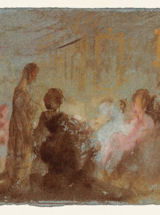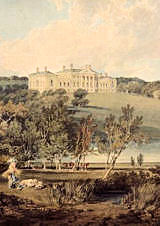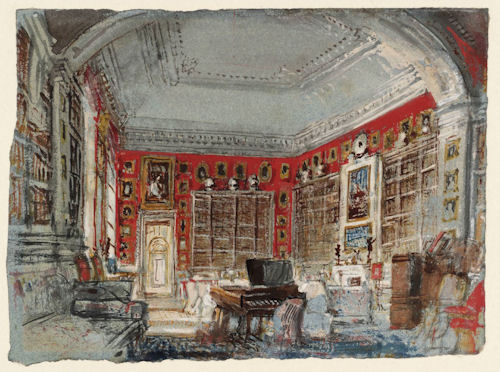




Literature's building blocks:
THAT Jane Austen's Pride and Prejudice is one of Literature's most artfully constructed novels. In analyzing its construction, a reader is put in mind forcefully of the building of a great mansion, each layer forming a perfect foundation for the floors to be placed above, resulting in a perfection of structure utterly suited to its purpose.
Introduction 3A – Fear and Loathing: The Filming of a Beloved Novel
THAT a literary work belongs to everyone who has read and loved it, and no one can prevent us hating the very idea of transforming our beloved Novel into film. But life goes on. And, sometimes, rather than detract from a novel, the best screen treatments add other deeper layers to a well-loved book. (So, too, unfortunately, do the excruciatingly bad ones, a fact that demands, and receives, close attention.) And either in spite of, or, perhaps, because of its several filmed treatments, Austen's Novel has proven to be the greatest story of romantic love in this the English language.
A Welcome Lack of Surprises:
THAT after the first few readings even of a masterpiece, words mean what we have come to expect them to, and our favourites remain our favourites precisely because we can trust them not to tell us more than we wish to know.
Benjamin Disraeli is said to have read Pride and Prejudice seventeen times. I wonder if he ever got to the point where the book had no more to offer than safe entertainment — no unpleasant surprises to be found in its pages. No unexpected filmed passages to jolt his inner vision into a new assessment of persons, scenes or interactions. No necessity to speculate on motivations and whether or not the author realized she was sometimes telling us only so much as the book's personages wished her to know. Mr. Darcy, for example, mostly a model of rectitude and truthfulness, in at least one regard was clearly lying in his teeth. No need to wonder why, in the first half of the book, the author tells us almost all about everything, when in the remainder we are told almost nothing about anything.
The Better Part of Wisdom:
THAT in Pride and Prejudice, as in life, the better part of wisdom lies in its silences.
________________________
Chapters 1 and 2: The Bennet Family, Cornerstone of the Novel
In Pride and Prejudice, Jane Austen has constructed a literary mansion of superlative strength and durability. Like all great architecture, each layer forms a perfect foundation for the layer to be placed above. Chapters One and Two are devoted exclusively to the members of the Bennet family. Mrs. Bennet, Mr. Bennet; Jane and Elizabeth; the three younger daughters: a perfect subterranean cornerstone not merely for the layer which is to come, but for the entire eventual building.
* * * * *
Chapter 3: Foundation (1), The Meryton Assembly, or Laying the Framework
With the family in place as cornerstone comes the necessity for fresh materials befitting the foundation of a structure destined to be a great mansion. Additional characters are required to interact with, and build upon our knowledge of, the members of the Bennet family; action is needed to carry out the intentions of the dialogue, as well as new venues to offer scope for the narrative. Chapter Three of Austen's Novel will provide part of the framework of that foundation.
Here for the first time we meet Mr. Darcy, and his words and actions at Chapter Three's Meryton Assembly will affect every succeeding page of the Novel. His pride, his seeming prejudice against his social inferiors, give rise to no small reactions of wounded pride and intense prejudice on the part of Elizabeth, the blameless object of his studied insult.
Chapters 4 to 12: Foundation (2), Netherfield, or Reinforcing the Framework
If the novel's comparatively lengthy Chapter Three dealing with the Meryton Assembly forms one part of the foundation, the entwining of the members of the Bennet family with the occupants of Netherfield in the remaining chapters of Volume I furnish the remaining reinforcing structures (as well as a good part of the Ground Floor).
Once the Novel attains the upper reaches of that great literary mansion, every personage on the lower levels will have been given the means to support a great amount of weight upon his or her shoulders. The blossoming affection between Jane Bennet and Mr. Bingley is given due attention by Miss Austen, but shifted to the sidelines with the main focus always on Mr. Darcy's increasing attraction to Elizabeth, Austen's heroine, despite his having cavalierly dismissed her at the Meryton Assembly as 'tolerable; but not handsome enough to tempt ME' in Chapter Three. By Chapter Ten, at Netherfield, he is inquiring if she does not feel a great inclination to dance a reel. She replies that she does not: 'And now despise me if you dare.'
Foundation (3): Foreshadowing, or Moving Up
In Austen's Pride and Prejudice each of the early chapters contains its share of offhand lines and seemingly artless, if not pointless, observations. But here is no apparent attempt to mystify: on the contrary, nothing at the end should be a surprise, because all in this Novel seems to have been foreshadowed and prepared for, and can lead to no other conclusion.
And only now, with the foundation well and truly and securely laid, will Austen move up to the main level of her imposing mansion.
* * * * *
With the attainment of Chapter Thirteen we have climbed methodically from basement to Ground Floor or main level of Jane Austen's great literary mansion. In these next chapters Austen will describe the more public, less introspective aspects of her story, as on that most firm of foundations, further material can be placed and integrated securely.
Chapters 13 and 14: Ground Floor (2), New Materials, Enter Mr. Collins
Chapter Thirteen serves notice that we have moved from careful preparation to (comparative) headlong action with the arrival of a letter from Mr. Bennet's cousin, Mr. Collins, on whom the Bennet house is entailed in default of male heirs. In short order Mr. Collins arrives in person.
Chapter 15: Ground Floor (3), New Materials, Enter Mr. Wickham
By Chapter Fifteen, Mr. Bennet, his daughters (and with them the longsuffering reader) are only too well acquainted with the tiresome Mr. Collins, freeing Miss Austen to introduce a further complicating factor in the arrival of the handsome and charming Mr. Wickham, about to become an officer in the militia stationed at Meryton.
Under the guidance of Miss Austen's expert pen, there ensues much ingenious enmeshing of these newcomers into the lives of the characters, as well as the plot:—
Chapters 16 and 17: Ground Floor (4), The Whist Party, or Unseen Preparations
At the Whist Party, the attractive Mr. Wickham 'not playing at whist', is free to confide in an attentive and gratified Elizabeth a great number of facts which appear to reveal Mr. Darcy in an extremely unpleasant light. When Elizabeth suggests that Mr. Wickham might be tempted to leave the neighbourhood, Wickham maintains that if Darcy wishes to avoid Mr. Wickham, Darcy must go.
Chapter 18 (5), The Netherfield Ball, or Continued Construction
Austen gathers all her characters together for the Netherfield Ball, including Mr. Bennet (but not, in spite of his brave words, Mr. Wickham). By the conclusion of the Ball, the stupid and vicious words of Mrs. Bennet, not helped by the disreputable behaviour of the younger sisters of Jane and Elizabeth, have doomed the blossoming romantic relationship between Jane and their host Mr. Bingley.
Chapters 19 to 23: Ground Floor (6), Finishing Touches Volume I
The final chapters of Volume I deal with the ramifications of that fateful long-awaited Ball, as it becomes clear that Mr. Bingley has been prevailed upon to leave Netherfield, and Jane, with no firm prospect of return, thus seeming to close off venue upward to the First Floor. Of course, Jane Austen has deftly and simultaneously prepared another better access as Charlotte Lucas snares for herself Elizabeth's rejected suitor Mr. Collins.
. . . . .
Pictures 3A
With the exception of Photos from film promotions in webpage
Introduction 3A, and the Hubble Footer,
most Pictures on these Pride and Prejudice and other
Austen webpages, are from the
Turner Bequest of the Tate Museum
Collection Online.
My intentions were quite otherwise, but Pictures, too, insinuate themselves into our minds, and some temptations are better not resisted, in case their avoidance leads to worse addictions.
Details of and links to all Pictures are found in the Pictures 3A webpage.
This HomePage 3A:— Literature's
Building Blocks and Pride and Prejudice:
 JMW Turner, 1818
JMW Turner, 1818
Title: Farnley Hall from the East
Medium: Bodycolour and chalk on paper
Dimensions: Support 311 x 394 mm
Private Collection, Turner Worldwide
Reference: TW0240, Wilton 587
 JMW Turner, 1827
JMW Turner, 1827
A Conversation Group
Medium: Gouache and Watercolour on paper;
Dimensions: Support 190 x 140 mm
Collection: Tate, Accepted by the nation as part of the Turner Bequest 1856
View by appointment at Tate Britain's Prints
and Drawings Room
Reference D22743
View by appointment at Tate Britain's Prints
and Drawings Room
 JMW Turner, 1798
JMW Turner, 1798
Harewood House from the south-west
Graphite and watercolour on paper; Dimensions: 510 x 654 mm
Collection Harewood House Trust
Turner Worldwide, Reference TW 0197, Wilton 219
 JMW Turner, 1827
JMW Turner, 1827
Petworth: the White Library, looking down the Enfilade from the Alcove, 1827
Watercolour, bodycolour and pen and ink on paper;
Dimensions: Support 143 x 193 mm
Collection: Tate, Accepted by the nation as part of the Turner Bequest 1856
View by appointment at Tate Britain's Prints
and Drawings Room
Reference D22678
________________________